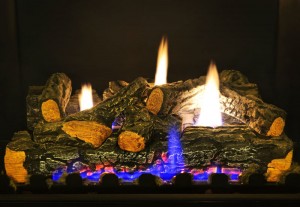
Gas logs are a popular option to replicate the look of a wood-burning fire without the mess or effort
A wood-burning fireplace requires chopping and carrying wood, arranging the logs in the fireplace to build the fire, and cleaning up the ashes. A gas log fireplace, on the other hand, requires pushing a button and omits the whole cleaning up of ashes. In a world of instant coffees and instant foods, instant flames were sure to follow. We can help you decide which set of gas logs is right for you.
A LITTLE FOOD FOR THOUGHT
Mull over these facts about wood-burning fireplaces as you ponder converting to gas:
• Wood fires may warm your heart and soul but don’t actually heat your living space. According to the U.S. Department of Energy, a wood-burning fireplace draws in as much as 300 cubic feet per minute of heated room air for combustion, and then, with a crackle, straight up your chimney it goes.
• Wood fires may expose you and everyone in your home to large quantities of toxic byproducts, including respiratory irritants, carcinogens and deadly carbon monoxide. The EPA warns of other health dangers, namely asthma, reproductive issues and birth defects.
• Wood smoke is a large contributor to air pollution — so much so that some localities ban the use of all wood burning, both inside and out, when pollution reaches a specified level.
• Your house is in danger should the creosote, a tarry byproduct of wood smoke, ignite inside your chimney. According to the CSIA, chimney fires are the cause of over 25,000 house fires in the U.S. each year, resulting in millions of dollars in property damage — as well as tragic loss of life.
• Traditional fireplaces are high-maintenance and require a lot of your time and energy to operate.
Some homeowners eventually give up on their wood-burning fireplaces altogether. Henceforth, it sits empty; the coziness it provided becomes a mere memory. Converting to gas can be an acceptable alternative since it allows you to regain much of the aforementioned coziness and, in some cases, the lost heat as well. Continue reading as we cover the most popular options available to you, should you decide to go this route.
VENTED GAS LOGS
If you’re in the market for a realistic-looking wood-fire substitute at a budget-friendly price, a vented gas log set will fit the bill quite nicely. The logs can simulate many different species of wood, and the flame and embers are pretty similar to their real-wood counterparts. They are convenient—no stacking, chopping or hauling wood is required. Some models even come with remote-controlled ignitions and adjustable flame controls, and none leave behind a mess.
However, because gas logs have the same open combustion as wood, many of the same dangers and health hazards exist. Nor do they provide appreciably more heat. The damper on your chimney must remain permanently open as the fire continually draws in your room’s air; some manufacturers even recommend keeping a window cracked during use of their vented gas logs. In addition to the obvious hazard of an open flame, older or defective vented log sets can circulate explosive gas into the air.
Vented gas logs are an economical, convenient replacement for those of you who are looking for the ambiance of real-wood units without the cleanup hassles associated with them. Keep in mind, however, that they are practical only for their ambiance.
GAS INSERTS
These units are the most appealing and sensible solution for a wood-to-gas conversion, but they typically have a much higher price tag associated with them. Springing for a gas insert can provide you with a beautiful fireplace that incorporates all of the desirable features that their wood-burning counterparts lack.
Unlike vented gas logs, inserts are actually more like heaters that operate at around 85% efficiency. They exhaust air to the outside, keeping byproducts out of your house and hourly operating costs to a few cents. As a natural gas product, they also add little in the line of outdoor pollution. Remote control operation adds another level of convenience. Their flames and glowing embers are every bit as mesmerizing as those of a wood fire. No electricity is required to run the majority of gas inserts, which is a huge plus in the event of a power outage; you’ll still be able to snuggle up with that special someone.
When you start to weigh the deciding factors — convenience, ecology, safety, health, efficiency and ambiance — converting your wood-burning fireplace to gas makes sense. The first step is to contact Northeastern Fireplace & Design here to discuss your chimney and fireplace needs. We’re ready to handle any and all of your fireplace needs!
